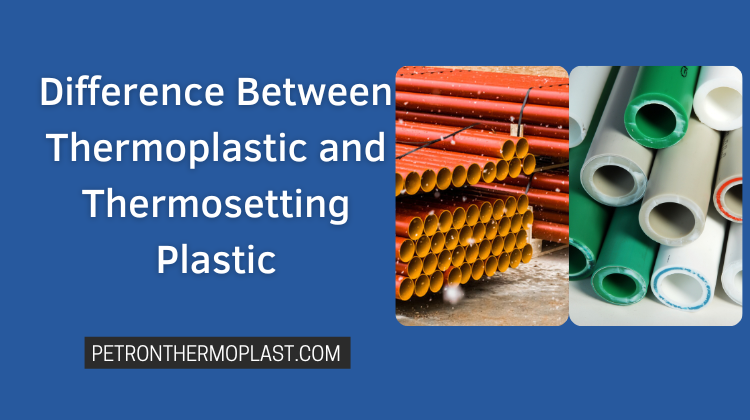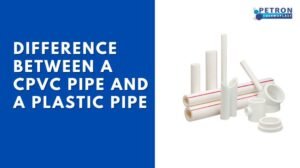Plastics are versatile materials used in a wide range of applications, from household items to industrial products. They come in two main categories: thermoplastics and thermosetting plastics. Before Understanding the difference between these two types of plastics first, we need to understand the type of plastic material.
Thermoplastic
Thermoplastic is a type of plastic that becomes soft and pliable when heated and solidifies when cooled. It is made up of long chains of polymers that can be melted and reshaped multiple times without undergoing any chemical changes. This property makes them recyclable and reusable, and it is one of the main reasons why they are widely used in a variety of industries.
Thermoplastics can be formed into various shapes, sizes, and colors using different manufacturing techniques such as injection molding, extrusion, and blow molding. They are commonly used in applications such as packaging, automotive parts, toys, medical devices, and household items.
Here are examples of thermoplastics including, polypropylene, polyethylene, polystyrene, and PVC.
Thermoplastic has several advantages over other types of plastics. They are lightweight, durable, and have good resistance to chemicals and impact. They are also easy to process and can be recycled multiple times without losing their properties. Moreover, they are relatively inexpensive, making them an affordable option for many applications.
Thermosetting Plastic
Thermosetting plastic is a type of plastic that hardens permanently when heated. It is made up of polymers that undergo a chemical reaction when exposed to heat, which causes them to cross-link and solidify. Once they are set, they cannot be remolded or reshaped, and they do not soften when exposed to heat.
Thermosetting plastics have a three-dimensional network of interconnected chains that are highly cross-linked, giving them exceptional strength and durability. They also have better resistance to heat, chemicals, and electricity than thermoplastic, making them suitable for use in high-temperature and high-stress applications.
Thermosetting plastics are commonly used in applications such as electrical insulation, automotive parts, construction materials, and aerospace components. Some examples of thermosetting plastics include epoxy, phenolic, and melamine.
One of the main advantages of thermosetting plastic is its exceptional strength and durability. They are also highly resistant to heat, chemicals, and electricity, making them ideal for use in harsh environments. However, once they are set, they cannot be melted or reshaped, which can make recycling or reusing them difficult.
Difference Between Thermoplastic and Thermosetting Plastic
Plastics are essential materials used in various industries such as automotive, construction, packaging, and consumer goods. They are classified into two main categories: thermoplastic and thermosetting plastic. Both types have unique characteristics that make them suitable for different applications.
Thermoplastic and thermosetting plastic differ mainly in their molecular structure and their ability to withstand heat. Thermoplastic is made up of long chains of polymers that can be melted and reshaped multiple times without causing any chemical changes. This property makes them recyclable and reusable.
On the other hand, thermosetting plastics are made of polymers that undergo a chemical reaction when they are heated, which causes them to harden permanently. Once they are set, they cannot be remolded or reshaped, and they do not soften when exposed to heat. Examples of thermosetting plastics are phenolic, epoxy and melamine.
In terms of their properties, thermosetting plastics are generally more rigid and durable than thermoplastics, which are more flexible and easier to work with. Thermosetting plastics also have better resistance to heat, chemicals, and electricity, making them suitable for use in high-temperature and high-stress applications. In contrast, thermoplastics have lower heat resistance and are less durable, but they are more versatile and can be used for a wide range of products.
The main Difference Between Thermosetting Plastic and Thermoplastic
Thermoplastics and thermosetting plastics differ in their chemical structure and properties. Thermoplastics are linear polymers that soften and melt when heated and harden when cooled. This property makes them easily moldable and recyclable. On the other hand, thermosetting plastics are cross-linked polymers that do not soften when heated. Once cured, they cannot be remolded or recycled.
Is PVC a Thermoplastic or Thermoset?
When PVC is heated, its long polymer chains slide past each other, allowing it to be molded into different shapes. Once it cools down, it solidifies again, but it can be reheated and reshaped as many times as needed.
In contrast, a thermoset material like phenolic or epoxy hardens permanently when heated. They undergo a chemical reaction when exposed to heat, which causes them to cross-link and solidify. Once they are set, they cannot be melted or reshaped again without undergoing degradation.
What are PVC diaphragm valves and PVC butterfly valves?
Both PVC diaphragm valves and PVC butterfly valves are types of valves used to control the flow of fluids in industrial applications.
A PVC diaphragm valve consists of a valve body, a diaphragm, and a stem. The diaphragm is made of a flexible material such as rubber or plastic, and it separates the valve body into two chambers. When the stem is turned, the diaphragm flexes and either opens or closes the valve, allowing or stopping the flow of fluids. PVC diaphragm valves are often used in applications where precise control of fluid flow is required, such as in water treatment plants or chemical processing.
A PVC butterfly valve, on the other hand, consists of a disc and a stem that are connected to a circular body. When the stem is turned, the disc rotates and either blocks or allows the flow of fluid through the valve. PVC butterfly valves are commonly used in applications where a larger flow rate is required, such as in water treatment plants, irrigation systems, and HVAC systems.
Both PVC diaphragm valves and PVC butterfly valves are made of PVC material, which is durable, lightweight, and resistant to corrosion and chemicals. PVC valves are often preferred over metal valves due to their lower cost, ease of installation, and resistance to chemical corrosion.
Example of Thermoplastic and Thermosetting Plastic:
Some common examples of thermosetting plastics include epoxy resins, phenolic resins, and melamine formaldehyde resins. These materials are used in electrical insulation, adhesives, coatings, and other applications where durability and heat resistance are required.
Some examples of thermoplastic include:
- Polyethylene (PE)
- Polypropylene (PP)
- Polyvinyl chloride (PVC)
- Polystyrene (PS)
- Acrylonitrile-butadiene-styrene (ABS)
- Polycarbonate (PC)
- Nylon
Some examples of thermosetting plastic include:
- Epoxy
- Phenolic
- Polyurethane
- Melamine
- Bakelite
- Urea-formaldehyde
- Silicone
These materials have different properties and characteristics, which make them suitable for a wide range of applications in different industries.
The Difference Between Thermoplastic and Thermosetting Plastic is crucial to understand for various industrial applications. Thermoplastic can be melted and reshaped multiple times without undergoing any chemical changes, while thermosetting plastic hardens permanently once it is set. This “Difference Between Thermoplastic and Thermosetting Plastic” makes them suitable for different applications in industries such as automotive, construction, and electronics.
By understanding the Difference Between Thermoplastic and Thermosetting Plastic, engineers and machined components manufacturers can choose the appropriate material for their specific application, ensuring optimal performance and durability. To know more get help with – Petron Thermplast
Few frequently asked questions are:
Q. What is the main difference between thermoplastic and thermosetting plastic?
The main difference is their ability to withstand heat and their molecular structure. Thermoplastic can be melted and reshaped multiple times without undergoing any chemical changes, while thermosetting plastic hardens permanently once it is set.
Q. Can thermoplastic be recycled?
Yes, thermoplastic can be recycled multiple times without losing its properties.
Q. Can thermosetting plastic be recycled?
No, thermosetting plastic cannot be melted or reshaped once it is set, which makes it difficult to recycle.
Q. What are some examples of thermoplastic?
Some examples of thermoplastic include polyethylene, polypropylene, polystyrene, and PVC.
Q. What are some examples of thermosetting plastic?
Some examples of thermosetting plastic include epoxy, phenolic, and melamine.
Q. Which type of plastic is more versatile?
Thermoplastic is more versatile as it can be melted and reshaped multiple times.
Q. Which type of plastic is more durable?
Thermosetting plastic is more durable as it hardens permanently and has a three-dimensional network of interconnected chains.
Q. Which type of plastic is more resistant to heat?
Thermosetting plastic is more resistant to heat than thermoplastic.
Q. Which type of plastic is more suitable for high-temperature applications?
Thermosetting plastic is more suitable for high-temperature applications due to its exceptional heat resistance.
Q. Which type of plastic is more suitable for electrical insulation?
Thermosetting plastic is more suitable for electrical insulation due to its high resistance to electricity.
Q. Which type of plastic is easier to process?
Thermoplastic is easier to process as it can be melted and reshaped multiple times using different manufacturing techniques.
Q. Which type of plastic is more expensive?
Thermosetting plastic is generally more expensive than thermoplastic due to its exceptional strength and durability.





Pingback: melo air
Pingback: 온라인 카지노
Pingback: free webcams
Pingback: Angthong National Marine Park
Pingback: 사이트